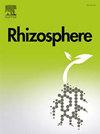Harnessing the role of rhizo-bacteria to mitigate salinity stress in rice (Orzya sativa); focus on antioxidant defense system, photosynthesis response, and rhizosphere microbial diversity
IF 3.4
3区 生物学
Q1 PLANT SCIENCES
引用次数: 0
Abstract
Salt stress threatens global food security, and although plant growth-promoting rhizobacteria (PGPR) can boost plant resistance and productivity, their field effects are poorly understood. Therefore, this experimental trial explored the mechanisms of PGPR-induced salt stress resistance on ion homeostasis, the photosynthetic system, enzymatic activities, and rhizosphere diversity in rice. The study was conducted in the first week of May 2022, using rice (Tongxi 945) seeds, which were pelleted at the seedling nursery and cultivated in the field under salinity conditions (0.5 and 2.35 g kg−1) with (+) or without (−) PGPR treatment. Na+/K+ concentrations, photosynthetic, leaf water potential, enzymatic activities, and changes in rhizosphere microorganisms were measured at the heading stage of rice. The findings of this study revealed that salinity stress significantly increased Na+ concentrations in leaves (257.70%), the leaf Na+/K+ ratio (567.96%), and leaf water potential (63.47%) while markedly reducing the net photosynthetic rate (71.72%), stomatal conductance (81.36%), thousand-grain weight (2.22%), and yield (114.15%). However, the application of PGPR mitigated the adverse effects of salinity stress by reducing Na+ concentrations in roots (45.22%) and leaves (26.20%), the root Na+/K+ ratio (64.68%), and leaf water potential (31.39%). PGPR also significantly improved the net photosynthetic rate (29.75%), stomatal conductance (46.89%), transpiration rate (25.56%), and chlorophyll content (11.95%). Applying PGPR significantly enhanced antioxidant enzyme activity, regulated carbon metabolism, increased microbial diversity in rhizosphere soil, and boosted the abundance of dominant fungal genera, alleviating salt stress damage to rice. Overall, PGPR improves microbial diversity, photosynthesis, and enzyme activities, mitigating salt stress effects. Further research is necessary to implement these findings in agriculture and evaluate their long-term impacts on crop productivity and soil health.
求助全文
约1分钟内获得全文
求助全文
来源期刊

Rhizosphere
Agricultural and Biological Sciences-Agronomy and Crop Science
CiteScore
5.70
自引率
8.10%
发文量
155
审稿时长
29 days
期刊介绍:
Rhizosphere aims to advance the frontier of our understanding of plant-soil interactions. Rhizosphere is a multidisciplinary journal that publishes research on the interactions between plant roots, soil organisms, nutrients, and water. Except carbon fixation by photosynthesis, plants obtain all other elements primarily from soil through roots.
We are beginning to understand how communications at the rhizosphere, with soil organisms and other plant species, affect root exudates and nutrient uptake. This rapidly evolving subject utilizes molecular biology and genomic tools, food web or community structure manipulations, high performance liquid chromatography, isotopic analysis, diverse spectroscopic analytics, tomography and other microscopy, complex statistical and modeling tools.
 求助内容:
求助内容: 应助结果提醒方式:
应助结果提醒方式:


